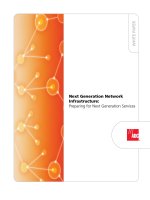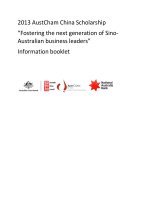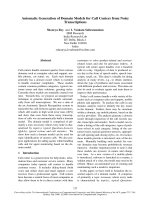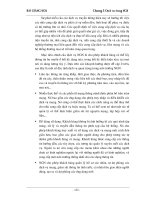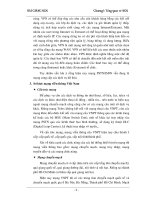Next generation of conducting materials for organic electronics 2
Bạn đang xem bản rút gọn của tài liệu. Xem và tải ngay bản đầy đủ của tài liệu tại đây (322.22 KB, 19 trang )
Summary of Amendments
Cover Page
The examiner suggests changing the thesis title
Reply: not changed.
Explanation: This thesis describes the basic synthesis of new materials
with the required semiconducting properties for further possible
applications in molecular electronics. In addition, we have investigated
the electrical properties of individual and stacked nano-plates which
showed interesting behavior. We stopped short of device evaluation
because of lack of time. We feel that the title is appropriate.
Chapter One
Page 5: spelling error
Reply: change ‘stared’
To ‘started’
Page 5: spelling error
Reply: change ‘summaries’
To ‘summarizes’
Page 5: grammar error
Reply: delete ‘beforehand’ in ‘However, beforehand fabrication of
nanomaterials…’
Page 6: expression modification
Reply: change ‘strong and weak aspects’
To ‘strength and weakness’
Page 6: grammar error
Reply: change ‘photoresist’
To ‘photoresists’
Page 7: expression modification
Reply: change ‘lay-by-lay’
To ‘layer-to-layer’
Page 7: definitions
Reply: add ‘Scanning Tunneling Microscope’ and ‘Atomic Force
Microscopy’ as the full names of STM and AFM, respectively
Page 7: grammar error
Reply: delete ‘of’ in ‘fabricate of nanostructured patterns’
Page 7: Add more details of reference 16 and 17
Reply: add in ‘The most remarkable demonstrations are the placing
of atoms in a particular location (reference 16) and the construction
of a quantum corral of 48 Fe atoms by STM (reference 17)’
Page 7: the definition
Reply: add ‘Molecular Beam Epitaxy’ as the full name of MBE
Page 9: expression modification
Reply: change ‘fill in pores’
To ‘fill into the pores’
Page 10: expression modification
Reply: change ‘derivative’
To ‘derivatives’
Page 11: expression modification
Reply: change ‘variations reaction’
To ‘variations of reaction’
Page 11: expression modification
Reply: change ‘no further purification process is needed’
To ‘no further purification is needed’
Page 12: grammar error
Reply: change ‘the nanofiber’
To ‘the nanofibers’
Page 12: expression modification
Reply: change ‘is companied by’
To ‘is accompanied by’
Page 12: grammar error
Reply: change ‘results in granular particulates’
To ‘results to granular particulates’
Page 12: The examiner questions the word ‘predisposition’
Reply: not changed.
Explanation: the word ‘predisposition’ (Adv. Mater. 2009, 21, 1487)
means the tendency for conjugated polymers to form linear anisotropic
structures.
Page 14: expression modification
Reply: change ‘A plethora of analytes are reported to be detected,130-142
which are classified into one or more of the five established
mechanisms.130 ‘
To ‘A plethora of analytes have already been reported.130-142 The
mechanisms are classified into the five established models.130’
Chapter Two
Page 27: the definition
Reply: add in Nomenclature ‘(An)’ as the short name for aniline
Page 30: The examiner questions how the diffraction rings and spots (Fig.
2.1c) are corresponding to the amorphous PANI spheres and gold
nanoparticles, respectively.
Explanation: Polymer chains have regular arrangements in local scale,
which corresponds to the weak rings; while the bright spots are due to
specific gold crystal structures.
Page 31: The examiner questions how the broad peak centered at
2θ = 29 o is ascribed to PANI.
Explanation: The very weak and wide peak centered at 2θ = 29
o
is
associated with X-ray diffraction of amorphous regions in PANI. It is
reported that protonated PANI powders generally have the ES-I structure,
which show a broad scattering centered at 2θ ~25
1991, 24, 779, figure 3(a)).
Page 34: grammar error
Reply: change ‘can be also’
To ‘can also be’
o
(Macromolecules,
Page 34: The examiner asks for more magnified SEM figures
Reply: not changed.
Explanation: For better comparison, the SEM in Figure 2.5 are of the
same magnification (x15,000) as the SEM in Figure 2.6 and 2.7.
Page 34: The examiner questions why the concentration of CTAB is low.
Reply: add ‘(and meanwhile the low concentration of CTAB)’
Explanation: the concentration ratio of CTAB to HAuCl4 was kept
constant in the experiment, thus the concentration of CTAB was lowered
when the concentration of HAuCl4 decreased.
Page 36: expression modification
Reply: change ‘different pressures’
To ‘different pressure levels’
Page 38: expression modification
Reply: delete ‘the’ in ‘at the atmospheric pressure’
Page 39: In comparison, the examiner asks for the conductivity value for
the PANI films at the reduced pressure.
Reply: calculate the conductivity from the equation (1) σ = L/(S·R)
Where σ is the conductivity, L is the length of the gap, S is the cross
section is of the PANI film, and R is the resistance. From Figure 2.8 the
length L is around 1×10-5 m, and the cross section are S is 5×10-11 m2.
From Figure 2.9 (c) the resistance R is around 2×109Ω from 3V to 4V.
Thus the value of conductivity is around 10-6 S/cm.
Page 41: The examiner questions ‘why the 1166 cm-1 band is considered
as a measure of the degree of delocalization of electrons in PANI’
Reply: not changed.
Explanation: According to the reference 51, the peak around 1140 cm-1 is
assigned to the mode of Q=NH-B or B-N(+)H-B in the doped state. After
dedoping process, the structure changes to N=Q=N, and the peak position
changes to around 1160 cm-1 accordingly. Therefore, this band is reported
(e.g. in reference 52) to be the measurement of electron delocalization
degree in PANI.
Page 42: The examiner questions ‘why the strong peak centered at about
950 nm with a free-carrier tail extending into the near-infrared region is
and indication PANI in doped state.’
Reply: not changed.
Explanation: According to the reference 18, the band around 1000 nm is
assigned to the polaron transition in doped PANI. In reference 19, the
position shifts lower to 800 nm when chloroaurate acid is used as the
oxidant to synthesize doped PANI nanofibers. More information can be
found in other references (Polymer 2006, 47, 5295 and Macromolecules
1995, 28, 2858).
Chapter Three
Page 48: The examiner comments that the two paragraphs in 3.1 are
‘repeated’.
Reply: not changed.
Explanation: The paragraphs in 3.1 give an introduction of chemical
synthesis methods for PANI nanostructures. Although some literatures are
mentioned and cited in the first two chapters, they are discussed in detail
and focused on the 2D structures in this Chapter.
Page 50: The examiner comments that the paragraph in 3.2.1 is
‘repeated’.
Reply: not changed.
Explanation: In Chapter Three, trioctylmethylammonium chloride
(TOAC) is used as surfactants instead of cetyltrimethylammonium
bromide (CTAB) in Chapter Two; other chemicals remain the same.
Page 52: The examiner comments that the paragraph in 3.2.4 is
‘repeated’.
Reply: not changed.
Explanation: The characterization methods are the same as those in
Chapter Two, but it is supposed as an integrated part in 3.2 Experimental
Section for clearer clarification.
Page 58: The examiner questions ‘why does PANI plate form’
Reply: not changed.
Explanation: In 3.3.1.1 the experimental results are described first and the
assumption on the plate formation is clarified in the section ‘Reaction on
glass’ (Page 61).
Page 60: The examiner question ‘glass beaker’
Reply: not changed.
Explanation: The glass beaker used in my experiments is the simple glass
container commonly used in laboratories.
Page 60: The examiner question ‘Is there a way to predict the point of
change’
Reply: Unfortunately, the exact point of morphology change can not be
predicated, this is why a lot of reactions were conducted under different
conditions.
Page 61: The examiner question ‘why PANI films were found adhered to
substrates in acidic aqueous reactions’
Reply: not changed.
Explanation: The acidic aqueous solution was traditionally adopted for
aniline polymerization. PANI films were found adhered to glass beakers
(reference 38) and other substrates (reference 28 and 39) under such
conditions.
Page 61: The examiner question ‘epitaxial growth of PANI on the glass
beaker wall’
Reply: not changed.
Explanation: Epitaxial nucleation and growth refer to a film fabrication
method, in which the deposited film takes on a lattice structure and
orientation identical to those of the substrate. In this thesis, ‘the epitaxial
growth of PANI’ means that PANI grew following the orientation of the
glass beaker wall and thus produced the 2D plate morphology.
Page 63: grammar modification
Reply: change ‘even diffuse to’
To ‘evenly diffuse to’
Page 64: The examiner question: ‘Thus the initial acidity inside
TOAC-HAuCl4 reverse micelles is much lowered.’
Reply: not changed.
Explanation: Mass transfer is reported to happen between reverse
micelles. In my experiments, when HCl/TOAC solution was mixed into
the HAuCl4/TOAC solution, protons were expected to transfer from
HCl-TOAC reverse micelles into TOAC-HAuCl4, thus the acidity in the
aqueous portion inside the reverse micelles would increase.
Page 65: grammar error
Reply: change ‘in background’
To ‘in the background’
Page 65: The examiner question ‘how to determine Au contents are below
3% mass percents’
Reply: the additional figure 3.11 (e) is added.
Explanation: The element distribution is reported in the form of mass
percents in Energy-dispersive X-ray Spectra (EDX) results, which is
added as Fig. 3.11e.
Page 67: grammar error
Reply: change ‘a strong peak around 850 nm’
To ‘a strong peak at round 850 nm’
Chapter Four
Page 76: The first paragraph in 4.1 is considered ‘repeated’
Reply: not changed.
Explanation: The first paragraph gives a very brief introduction of
different methods used to synthesize micro and nano structures of
conducting polymers, which is closely related with the synthesis section
in this chapter.
Page 76: The examiner question ‘reverse micelles in non-polar solvents’
Reply: not changed.
Explanation: Compared with the direct micelle in aqueous solution
water-in-oil micelle), the reverse micelle in non-polar solvent (such as
toluene) forms an aggregate with the hydrophobic tail outside in contact
with surrounding solvent and the hydrophilic head inside the micelle
centre.
Page 77: misunderstanding expression
Reply: change ‘It would therefore be interesting to investigate the
influence of surfactant type on the morphologies and electrical properties
of PANI’
To ‘It would therefore be interesting to investigate the influence of
surfactant type on the PANI morphologies and electrical properties.’
Page 77: The examiner question ‘In contrast, no electrical property of 2D
structures has been discussed23’
Reply: not changed.
Explanation: In the reference 23, two-dimensional plate-like PANI is
successfully synthesized, but no properties have been tested. Thus
electrical property was investigated on the prepared PANI plates.
Page 77: format error
Reply: move the title ‘4.2 Experimental Section’ from the last line of
this page to the next page (Page 78).
Page 78: The paragraph in 4.2.1 is considered ‘repeated’.
Reply: not changed.
Explanation: This paragraph gives the chemicals used in the synthesis
section, which is necessary in an independent chapter.
Page 79: The examiner question ‘Figure 4.1 repeats Figure 3.7’.
Reply: not changed.
Explanation: The two figures have a slight difference. In Figure 4.1,
trioctylamine
is
used
as
the
surfactant
instead
of
trioctylmethylammonium chloride (TOAC) in Figure 3.7. This difference
is marked on the top of Figure 4.1.
Page 79: The paragraph in 4.2.4 is considered ‘repeated’.
Reply: not changed.
Explanation: This paragraph gives the methods used for characterizing
PANI structures, which is necessary in an independent chapter.
Page 80: expression modification
Reply: change ‘drop case on an insulating SiO2 substrate’
To ‘drop case onto an insulating SiO2 substrate’
Page 80: The paragraph in 4.2.5 is considered ‘repeated’.
Reply: not changed.
Explanation: This paragraph gives the methods used for measuring the
electrical properties of PANI films and individual structures, which is
necessary in an independent chapter.
Page 82: Figure 4.2 inset title error
Reply: change to ‘SEM images with an enlarged SEM inset (b) and
TEM insets (c, f) of the PANI micro and nano structures’
Page 83: Figure 4.3 inset title error
Reply: change to ‘SEM images with an enlarged SEM inset (a) and
TEM insets (b, c) of the PANI micro and nano structures’
Page 84: The examiner question ‘the epitaxial growth of PANI’.
Reply: not changed.
Explanation: Epitaxial nucleation and growth refer to a film fabrication
method, in which the deposited film takes on a lattice structure and
orientation identical to those of the substrate. In this thesis, ‘the epitaxial
growth of PANI’ means that PANI grew following the orientation of the
glass beaker wall and thus produced the 2D plate morphology.
Page 84: grammar error
Reply: change ‘in the Chapter 3’
To ‘in Chapter 3’
Page 85: The examiner question ‘the last step of pick-and-place process’.
Reply: not changed.
Explanation: In references 58 and 59, ‘the pick-and-place process’ refers
to the processes of picking up and putting the nanostructures synthesized
in the first step to the prescribed positions.
Chapter Five
Page 98: grammar error
Reply: change ‘the main purpose of this study is to’
To ‘the main purpose of this study was to’
